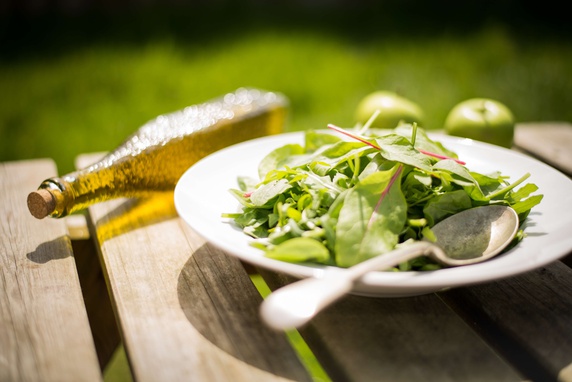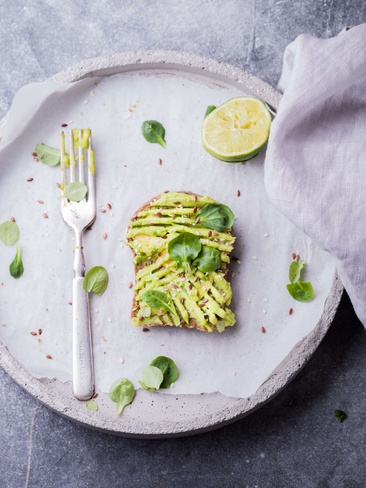Hippocrate disait vrai : Que ton aliment soit ta seule médecine ! (Hippocrate ; La loi, XIII – IVe s. av. J.-C.) Combien de fois n’avons-nous pas entendu cette citation du célèbre médecin et philosophe grec, Hippocrate. Elle circule de plus en plus sur les sites de santé naturelle et même sur Facebook afin d’ouvrir un maximum les consciences.
En effet, les études n’ont plus à le démontrer, c’est en s’alimentant mieux qu’on réussira à obtenir un équilibre de vie visant à la bonne santé. En terme d’alimentation, beaucoup de choses peuvent être changées dans le quotidien mais la priorité – à mon sens – est la bonne qualité des lipides qu’on décidera d’intégrer dans son alimentation.
Qu’est-ce qu’une huile ?
L’huile est un corps gras composé d’atomes de carbone, d’hydrogène et d’oxygène, liés par leurs champs électroniques et assemblés en molécules de glycérine et acide gras. La combinaison d’ensemble constitue les triglycérides, mais par convention, l’huile est qualifiée par ses acides gras. Aussi, le corps gras peut être d’origine animale, végétale ou minérale.

Attardons-nous aujourd’hui sur les huiles dont l’origine est végétale. Les huiles végétales transportent des actifs qui préexistaient déjà dans le végétal dont il est issu, ce sont des composants liposolubles intéressants pour notre santé.
En fonction de leur structure moléculaire, les lipides pourront être scindés en plusieurs catégories : saturés, mono ou poly-insaturés. Ces derniers font partie des huiles qu’on appelle Oméga 3, Oméga 6 et Oméga 9. Selon le résumé du Docteur Pascal Boyer, les omégas 3 et les omégas 6 sont indispensables et participent à la construction des phospholipides des membranes cellulaires, à la croissance, au développement du système nerveux. De plus, ils sont les précurseurs des prostaglandines, fragiles médiateurs cellulaires de l’information.
Quelques exemples :
- L’huile de périlla – perilla frutescens– contient 94% d’acides gras insaturés avec une proportion de 60 à 65 % d’oméga 3.
- L’huile de cameline – camelina sativa– contient 70% d’acides gras insaturés avec une proportion de 30 à 35 % d’oméga 3. De plus, elle est riche en provitamine A et en vitamine E, permettant alors une bonne action antioxydante.
- L’huile de colza – brassica napus– contient 93% d’acides gras insaturés avec une proportion de 10% d’oméga 3
- L’huile de lin – linum usitatissimum– contient 91% d’acides gras insaturés avec une proportion de 55% d’oméga 3. Pour cette huile, il existe une précaution d’emploi très importante car elle rancit rapidement si elle n’est pas conditionnée au réfrigérateur.
- L’huile d’olive – olea europaea– contient 83% d’acides gras insaturés dont 72% d’oméga 9 et 1% d’oméga 3.
- L’huile d’argan – argania spinosa– contient 82% d’acides gras insaturés. Elle se rapproche dans sa composition de l’huile d’olive.
- L’huile de chia – salvia hispanica– contient 91% d’acides gras insaturés dont 62% d’oméga 3. Merveilleuse huile au niveau nutritionnelle mais son utilisation sera principalement cosmétique. De plus, c’est un produit originaire du Mexique qui est difficilement accessible en Europe.
- L’huile d’avocat – persea gratissima– contient 82% d’acides gras insaturés. Elle sera recommandée pour ses bienfaits nutritionnels en vitamine D, E et H.

Dans notre consommation quotidienne, il sera important de privilégier les huiles végétales de qualité biologique et de première pression à froid. De plus, les huiles de ce type ne sont pas constituées pour être chauffées – excepté pour l’huile d’olive qui peut monter à une température de 200 degrés approximativement. Néanmoins, si vous choisissez une huile d’olive de qualité extra vierge, celle-ci ne sera pas ,non plus, adaptée pour la cuisson. Dès lors, considérez bien ces huiles comme des huiles à consommer crue, en accompagnement et en assaisonnement.
Sources : Les bienfaits des huiles végétales aux Editions Marabout



